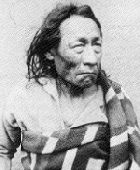 KICKING BEAR gained his notoriety from his participation in and
leadership of the Ghost Dance movement among the Sioux Indians in the
KICKING BEAR gained his notoriety from his participation in and
leadership of the Ghost Dance movement among the Sioux Indians in the
Once the European
settlers came to Western Canada, the way of life for the aboriginals was
threatened and Big Bear, a Cree Chief, fought, through protests of peace to make
things better for his people. He was branded a troublemaker. Big Bear had fought
the authorities by word, his people fought with bullets and both lost. By 1887,
Big Bear's people were scattered throughout the country, most of his family was
in Montana, he died alone in January of 1888.
Big
Bear, like Louis Riel, was one of the leaders of the Metis and Plains Indians
who tried to unite and press John A. Macdonald's government for native rights.
In 1876, Big Bear refused to sign a treaty he believed would sacrifice his
people's rights in exchange for a reserve. But with buffalo gone and the Cree
facing starvation, the treaty was signed in 1882. Big Bear lost control of some
of his warriors which resulted in Wandering Spirit and his men killing nine
settlers at Frog Lake, north of today's Lloydminster, and burning Fort Pitt near
the Alberta-Saskatchewan border. The warriors were eventually hanged and Big
Bear was found guilty of treason and sent to Stony Mountain penitentiary near
Winnipeg. After two years, he was released to the Poundmaker reserve near North
Battleford, Sask., and died a year later.
Return to table of contents



